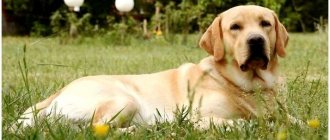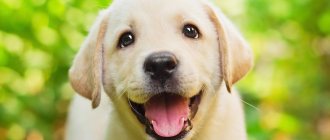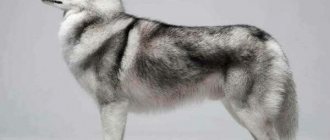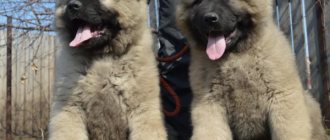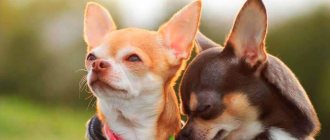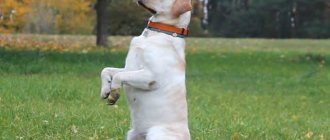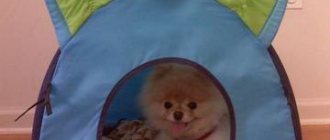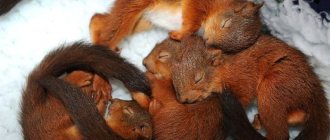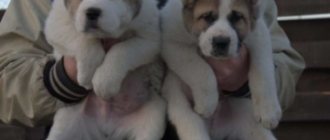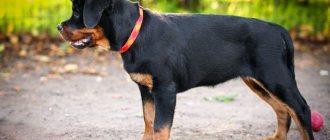Labradors are very gentle, affectionate and friendly dogs. This big and soft animal will become a faithful friend for the whole family. It is very important to take care of your pet's health. The owner must know how much a Labrador weighs and how to maintain the pet’s weight in ideal condition.
Labradors are affectionate and playful dogs that love outdoor games.
How much should an adult pet weigh?
Every owner should know well how much a Labrador should weigh. The indicator changes with age, so you need to monitor the diet of both puppies and adult dogs. Boys weigh more than girls and their bodies are larger and stronger. Special tables that indicate the animal’s age, weight and height help you monitor your pet’s weight.
Puppies actively grow and develop up to 12 months.
After this age they no longer change. Labradors tend to be overweight, but love running and active games. Obesity leads to severe diseases of the cardiovascular system and premature death, so you need to keep a close eye on your dog's health. Attention! The normal weight of an adult girl is 22–33 kg, and that of an adult male is 28–36 kg.
Girls weigh 22–33 kg and boys 28–36 kg
To what age do they grow?
There are three stages of maturation and growth of a Labrador puppy:
- The first four months are a pronounced growth.
- From five to eight months – a slowdown in growth rates.
- From nine months to one year – a slight increase in height and weight.
It is believed that from the age of one year dogs can already take part in exhibitions, their body is fully formed. There are three breed standards: international, British and American.
World and English are very close to each other, these are strict standards . They allow deviations from the reference height of up to one centimeter.
The American allows the dog to be three to five centimeters below or above the standard.
The weight of Labradors is not so clearly regulated, the main thing is the ratio of weight and height.
Dimensions (height at withers, etc.) for an adult Labrador, depending on gender
Breed standards have strict requirements for the size of animals. The height of a female Labrador must be at least 55 cm. The height of a male Labrador at the withers reaches 57 cm. You can measure the dog’s height and other physiometric indicators yourself at home.
Breed standards and parameters, what a Labrador should look like:
- The hind legs are stronger and more developed than the front legs.
- The large head is wedge-shaped.
- Massive muzzle.
- Straight nose.
- Wide nostrils.
- Medium size eyes.
- The tail is straight and long, wide at the base but tapering towards the tip.
The future owner who is interested in the Labrador breed should know about this: the size of this dog depends on age, gender and quality of food.
Girls grow up to 55 cm at the withers, and boys - up to 57 cm
Useful video
From the video you will learn everything about the Labrador dog breed:
Rate the author's article:
3 ratings, average: 5.00 out of 5
Loading…
The distinctive characteristics of the Labrador breed make its representatives popular and desirable human pets. Due to their friendliness, cheerfulness and strength, the animals are suitable for a variety of work activities and are suitable for a variety of owners, including children, whom dogs love and quickly become attached to.
Puppy weight and sizes from 1 to 12 months
Puppies grow and develop rapidly. The owner must closely monitor the baby’s health and feed him properly. The normal weight of a Labrador by month can be tracked in the table. Body weight may change slightly throughout life.
Newborns weigh 40–55 grams. They gain 120 grams per day. It is very important that a nursing dog eats well. If the puppies are left without a mother, the owner will have to feed them himself using a special milk formula for puppies.
Table No. 1. How a puppy grows
| Puppy age | Weight | Height at withers | Chest circumference |
| 1 month | 3.5–3.8 kg | 23–23.5 cm | 37–38 cm |
| 2 months | 7–8 kg | 30–32.5 cm | 45–46 cm |
| 3 months | 12–14 kg | 39.5–42 cm | 51–56 cm |
| 4 months | 17–19 kg | 44–46 cm | 60–64 cm |
| 5 months | 21–22 kg | 48–51 cm | 66–68 cm |
| 6 months | 24–26 kg | 50–55 cm | 67–70 cm |
| 7 months | 26–28 kg | 52–56 cm | 69–74 cm |
| 8 months | 28–30 kg | 54–57 cm | 70–76 cm |
| 9 months | 30–32 kg | 55–59 cm | 70–77 cm |
| 10 months | 30–36 kg | 55–59 cm | 70–84 cm |
| Over 11–12 months. | 30–40 kg | 55–59 cm | 70–85 cm |
Another breed related to the Labrador, the retriever, has the same standards. These dogs weigh 25–40 kg. Golden, fawn, brown or black retrievers grow to 56–57 cm (boys) or 54–56 cm (girls).
A 1 month old puppy weighs about 3 kg
Brief history of formation
Much of its history remains a mystery; different sources offer numerous versions of its origin. One is definitely a dwarf Labrador - it came from an aboriginal dog - the Newfoundler, which was widely used to help fishermen. The dog pulled nets out of the water, could pick up fish, and actively participated in hunting small game.
- The Europeans, who had their eye on the bright dog, happily took several puppies for themselves, after which they immediately gained popularity.
The peculiarity of a non-conflict nature and diligence allowed the breed to be used as guide dogs. A kind character and acceptable appearance, the ability to interact with people, helped to gain a foothold in society, both among wealthy people and ordinary hard-working people.
The first Labrador standard officially registered with the Canine Federation was adopted in 1905. The breed is named after the peninsula of the same name.
Today, representatives are widespread throughout the world, and work is still underway to improve their breeding appearance and character.
Species in Labradors
Labrador is a retriever and the description of the Labrador breed does not provide for any varieties in size and characteristic differences in exterior.
The only differences between representatives may be in color and its saturation. All sizes of the animal are clearly stated in the standard descriptions; there is no talk of any varieties.
Types in Labradors are divided into basic differences in color and coat, as well as some characteristic differences in the animal's personality.
- Golden ones are calmer;
- Straight-haired - may be more wary and lazy;
- Curly hair is the best guard for a home;
- The Nova Scotian is an ideal guard, but is less predisposed to training;
- Black is more obedient.
These descriptions are not directly related to the standard, the information only conveys the characteristics of behavior, but all descriptions are more common between owners. Officially, the first dog was a black Labrador, which was the only one for a long time, after which breeding of other colors was allowed.
How to measure height correctly
If the owner decides to find out how his Labrador has grown, the height at the withers can be measured independently at home. To do this you will need a ruler or measuring tape. You should not use a metal tape measure, because it can injure the owner and pet.
It is necessary to measure the distance from the foot to the withers. To do this, the dog must stand on 4 legs. You should not try to measure the height of a sitting dog, because this will be the distance from the tailbone to the withers, that is, the length of the spine.
How to try on an adult dog:
- Persuade the dog to stand still. You can use the “stay” command or distract your pet with a treat.
- Apply a ruler or tape measure to the dog's body. One end is to the floor at the level of the soles of the paws, and the other is at the level of the withers.
- After this, you can measure other parameters: girth of the head, chest, neck, length of paws and tail, etc.
- The height of the body at the sacrum should be measured from the floor to the highest point of the croup.
- Body length is measured as follows. One end of the ruler is applied to the shoulder, and the other to the ischial tuberosity.
- After this, you can compare sizes and display the average index. This index represents the ratio of one animal parameter to another.
At exhibitions, the elongation index (the ratio of body length to height), the bone index (the ratio of wrist circumference to height), etc. are calculated. These indicators make it possible to determine how well the dog meets the breed standards.
How to measure height at the withers
The withers are a small depression between the shoulder blades. It is formed by 5 cervical vertebrae (C1-C5). The withers are the highest part of the body that does not move in relation to the ground, so it is convenient to take it as a reference point.
The skin in this area is not too sensitive, so many injections are given at the withers. Flea drops are applied to this area because the dog will not be able to lick them off. The owner also needs to measure the circumference of the withers to choose a comfortable collar for the pet.
It is advisable to accustom such a large dog as a Labrador to regular height measurements - the height at the withers should be measured approximately once every six months. This procedure must be carried out before exhibitions and competitions. The growth of small puppies should be measured every week.
Interesting fact! The word “withers” comes from the word “groom”. It is this part of the pet’s body that is stroked and caressed.
Table of weight and other parameters by month
International breed standard
There are 3 types of standards for the Labrador breed. The most common international standard is FCI (Fédération Cynologique Internationale). The English standard is almost entirely FCI compliant. The American standard allows for errors in growth rates of 3-5 cm.
Exterior
The dog is large and strong. The body does not look overweight or stretched. Proportional addition. The dog is mobile, the muscles are clearly visible. Wide chest and forehead. Strong hindquarters.
Labrador retriever males are larger and more courageous than females and have a massive head. Bitches look more graceful, lighter built, the pelvis is larger than the head.
For males, the ideal height at the withers is 56-57 cm with a weight of 28-36 kg. For females, height ranges from 54-56cm, weight – 24-32kg. Deviations in height are allowed within 1 cm.
Weight indicators are not strictly regulated and are recommendations, however, you should pay attention to the consistency of the dog’s appearance and weight. Excess weight may indicate obesity; underweight may indicate poor nutrition or illness.
Head
Pronounced and large. The length of the muzzle corresponds to the length of the head. The line of the nose is almost parallel to the line of the skull, with a pronounced transition to the facial part. Sometimes there is a characteristic bump on the back of the head. The skin is tight, without sagging. The arrangement of teeth is linear. A straight bite is considered acceptable. The incisors are long, but not pointed.
The eyes are set deep in the sockets. Lively, expressing intelligence and interest. Eye color is predominantly brown .
The ears are hanging, but not heavy, triangular in shape. They fit tightly to the cheeks, but lag behind during movement.
Frame
The neck is well defined and of medium length. Provides high mobility. Without sagging or bulging, it has a pronounced scruff. The back is straight, without humps or sagging. The croup is wide and short. The chest extends beyond the line of the paws when viewed from the front. The ribs are well sprung. The stomach is tucked up, not drooping.
Limbs
The forelimbs are level, stand at right angles to the ground and are located exactly under the body. A characteristic feature: the shoulder blade forms a right angle , and the length of the shoulder blade is equal to the length of the shoulder.
The hind limbs are powerful. The lower leg is slightly elongated. The hock joints are set low. The croup is straight without slope. The paws are round, compactly gathered into a ball. The pads of the dads are spaced well enough to distribute the load when walking.
To read: Care and education of the Estonian hound, dog price and owner reviews
Tail
The tail tapers towards the end from a thick base, so its appearance resembles that of an otter. The fur on the tail is rough. In a calm state, the tail droops; when excited, it rises to the level of the back.
Coat and color
The coat is short and uniform, without bald spots. The undercoat is oily and water-repellent.
Colors: pure black, chocolate (liver) brown, cream, chestnut, yellow. A light star on the chest is allowed.
Character
The character is soft and obedient, active and playful. Loves to swim. Labrador is good-natured towards adults, children, and other dogs. Has good instincts and loves to hunt. Very efficient. Strives to please the owner.
According to dog attack statistics in America from 1982 to 2014, the Labrador ranks 9th out of 73 dogs. Despite the fact that the dog is not at all aggressive, it still requires attention and training .
The most common Labrador breed inconsistencies that you need to pay attention to when choosing and raising a dog:
- Males are similar to females.
- Aggressive or timid character.
- Long or short legs.
- Elongated or shortened body.
- White or colored spots, uneven color.
- Small head, short or narrow muzzle, uneven nose line.
- Semi-erect ears.
- Slanty eyes.
- Caries.
- Long neck.
- Narrow withers, pointed shoulder blades.
- Sagging back.
- Short or long tail.
- Narrow chest.
- Sagging belly.
- Small distance between fore and hind legs.
- Clubfoot.
- Heavyness, swaying of the croup vertically when walking.
What affects a puppy’s parameters
Babies need to be taken care of long before they are born. The health and size of a puppy depends on many important factors:
- Intrauterine development and lactation period. During pregnancy and lactation, the dog must eat well and be carefully protected from stress and infections. Her diet should contain all the necessary vitamins and minerals.
- All boys are bigger than girls. If the puppy is smaller than his sisters, he needs to be fattened and shown to the veterinarian to find out about possible pathologies or infections.
- The fewer puppies are born at a time (in one litter), the larger they will be. Conversely, multiple pregnancies produce very small puppies.
- Early introduction of complementary foods will help babies grow and gain weight quickly.
- One part of a puppy's body may grow faster than the rest. This is a normal process; by the age of one year the body will be folded proportionally.
- Physical activity is very important for older puppies.
- It is necessary to expel worms from the animal’s body in a timely manner. There will be no weight gain due to parasites.
- Bone health is extremely important. The skeleton develops up to 6 months. If it is poorly developed, then it will not be possible to correct it in the future.
For the health of children, it is necessary to create a proper diet for them and a schedule of walks with physical activity.
Up to 4 months, puppies grow rapidly, then their growth becomes slower and stops by the age of one year.
First vaccinations
At the age of 1 month, the puppy needs to be dewormed.
The first comprehensive vaccine for dogs against distemper, infectious hepatitis, parvovirus enteritis, parainfluenza and leptospirosis is given 10 days after deworming. After 14 days, a second comprehensive vaccination is given, at this stage vaccination against rabies is also carried out. Quarantine lasts 10-14 days after the second vaccination, revaccination - once a year.
Puppies are vaccinated according to the schedule from the vaccine manufacturer. Veterinary clinics offer vaccines from domestic and imported manufacturers, for example, Biovac, Multikan, Nobivak, Vanguard, Duramun, Eurikan.
What to do if your weight is below normal
Puppies must be weighed every day. Due to poor diet or illness, your Labrador's weight may be below normal. This often happens when infected with worms, and then you need to give the puppy an anthelmintic.
It is necessary to add nutritious and high-calorie complementary foods, as well as vitamins and minerals, to the baby’s diet. You should definitely contact your veterinarian.
Attention! In many cases, puppies and teenage dogs lose weight due to abnormal metabolism. A visit to the veterinarian is necessary.
If the puppy is not growing well, it must be well fed and the help of a veterinarian will be needed.
Is it possible to feed homemade food?
The proper nutrition of a two-month-old Labrador depends on his appearance and health, including in the future. With a balanced diet, the puppy is alert, active, in a good mood, its coat is shiny, and its weight increases gradually.
A small puppy can be fed homemade food. This is preferable, since natural products containing natural nutrients will initially strengthen the immune system and stimulate the full development of internal organs.
However, you need to prepare for the fact that this method of feeding is much more expensive, it takes time to prepare food, and the baby’s teeth will have to be brushed regularly.
Per day, a dog 2 months old should eat:
- 15 g of meat per kg of weight;
- 5 g carbohydrates per kg of weight;
- 2 g fat per 2 kg weight.
Also, the puppy should always have fresh, clean water freely available, and the bowl should be changed regularly.
Products that a dog needs:
- raw beef, chicken meat;
- raw sea fish;
- boiled chicken eggs;
- porridge with meat broth - rice, oatmeal, buckwheat;
- vegetables - fresh, quickly boiled;
- greens and fruits;
- milk;
- fermented milk products - yogurt, fermented baked milk, kefir, yogurt, cottage cheese.
Raw meat pieces are also mixed into the porridge.
Early in the morning you can give your baby cottage cheese with sour cream, oatmeal flavored with a small amount of honey. At 10 o'clock in the morning the dog should have a hearty meal of porridge with vegetables and sliced meat. At lunchtime, the animal is given milk, cottage cheese or any fermented milk drink. Boiled eggs are fed once a week. At 10 pm, the pet is offered meat or fish (only raw). In total, a Labrador puppy at 2 months is fed 5 times a day.
Products that should not be on an animal's menu:
- sweets, including chocolate;
- sausages and sausages;
- potatoes, onions and garlic;
- grape;
- pork;
- chicken, boiled and tubular bones.
It is necessary to ensure that your pet is not allergic to honey and buckwheat porridge - dogs love buckwheat, but often suffer from intolerance to this grain
Also note: if the baby licks the plate, this means that he is still hungry
Labrador is overweight
Labradors are big food lovers. These dogs have an excellent appetite, so they easily gain excess weight. The boy (cable) eats more than the girl. Obesity seriously harms the heart, blood vessels and joints.
Walks should become longer, it is advisable to play outdoor games with the Labrador more often, let him run and jump.
Sometimes the cause of obesity is thyroid disease, then the dog is prescribed a course of treatment.
With age, closer to 10 years, Labradors almost always gain weight and their metabolism slows down. An older dog needs a balanced diet.
If your pet has gained extra pounds, it is urgent to correct its diet and physical activity. This will require consultation with a veterinarian. It is necessary to reduce the amount of carbohydrates in your pet’s diet.
Features of feeding and diet
Nutrition for puppies is important in principle, but for Labradors, who love to eat, it is doubly important. Newborns feed only on mother's milk, but here, too, a certain schedule must be followed:
- 12 times a day for the first week;
- 8 - in the second;
- on the third - 6.
The owner’s task in this case is to ensure that the female feeds the babies in a timely manner. But somewhere around 3-4 weeks the baby may not have enough maternal nutrition, so it is important to know what to feed your Labrador puppy during this period.
Natural nutrition
Natural products can be used as complementary foods for a growing body: the basis (50-60%) should be meat, a little less (30%) cereals and 10-20% vegetables. Boiled eggs, boiled sea fish, offal, cottage cheese or kefir will also fit perfectly into the menu. You should definitely avoid the following foods in your Labrador's diet:
- sweets;
- pickles;
- milk;
- fatty meats;
- potatoes, cabbage, onions.
Food for a puppy should not be cold or hot, salt and spices should not be added to it. It is advisable to introduce foods gradually, one at a time, monitoring the growing body’s reaction to complementary foods. Important! Labradors are easy to overfeed because they love to eat, but overfeeding in their case can lead to obesity. Therefore, it is recommended to remove leftover food immediately after feeding, rather than leaving it for the baby.
Dry food
Dry food can be given to babies starting from the sixth week, when baby teeth appear. To begin with, give one granule, then the next day a couple and so on, so that the addiction is gradual.
There are several points that play an important role in feeding with dry food:
- choose only high-quality brands that avoid the use of harmful substances in the composition;
- It is advisable not to change the chosen brand in the future, this may cause stomach upset in the baby;
- It is necessary to feed the puppy dry food 5-6 times a day;
- It is advisable to create a feeding schedule and stick to it day after day.
Dry food is an excellent option for babies, because their balanced composition contains all the necessary additives and microelements for the harmonious growth and development of a Labrador.
Tips for weight control and nutrition
To prevent your dog from gaining extra pounds, he must eat right and walk a lot.
It is important to know what food to choose for your pet. It is advisable to choose high-quality premium or holistic food. You can feed your dog natural food: it’s healthy, but cooking will take a lot of time. It is necessary to strictly monitor the amount of food eaten: the dog must not overeat. Dry food packages always have a table indicating the daily intake.
Exercise strengthens your dog's bones and muscles. Labrador needs to run and play a lot. This will protect him from obesity and heart problems.
A caring owner carefully monitors the pet's weight. The dog must be well fed, but not overfed. Nutrition should be balanced and varied. With good care, your Labrador will live a long and happy life. The normal weight of an adult Labrador will ensure his health and longevity.
Household practice
Knowing the exact dimensional parameters greatly facilitates the life support of a shaggy pet. Labradors are famous for their playfulness, restlessness and tendency to roll around in a nearby puddle until they get terribly dirty. To make life easier for the owner, the market offers a huge range of clothing to protect against cold, excessive moisture and pollution. Knowing the exact size of the dog, it’s easy to choose a wardrobe for any season and occasion.
Also, based on the exact size of the dog, all pet equipment is selected/purchased (ordered for individual production): collars, harnesses, beds, booths, cages and other accessories.
Everything must correspond to the individual parameters of the dog - be appropriate, convenient and practical, regardless of whether the Labrador is large , small or .
Popular nicknames
The question of what to name a puppy should be taken seriously. The name should be simple and suitable for the pet.
The following nicknames are suitable for male Labrador puppies:
- Tyson;
- Jack;
- Bonya;
- Caesar;
- Rex;
- Hachiko;
- Graph;
- Baby;
- Ricci.
The girl can be called by the following names:
- Jaycee;
- Alma;
- Lucky;
- Bagheera;
- Gerda;
- Jesse;
- Nika;
- Eve.
